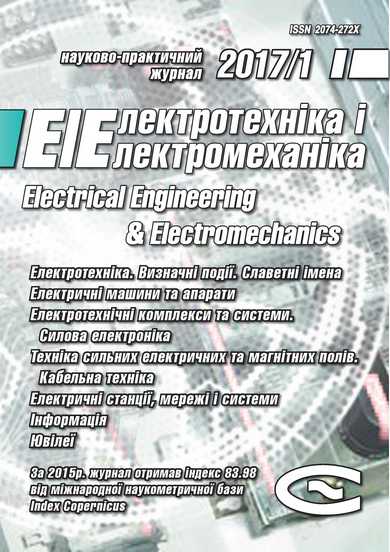INVESTIGATION OF MECHANICAL STRESSES IN THE DRIVE SHAFT OF MV VACUUM CIRCUIT BREAKER
DOI:
https://doi.org/10.20998/2074-272X.2017.1.02Keywords:
vacuum circuit breakers, mechanical calculations, shaft deformationAbstract
Introduction. In the last 10-15 years a dominant position in the market of medium voltage circuit breakers, vacuum circuit breakers have taken in which as an actuator mono- or bistable actuators with permanent magnets are used. Such circuit breakers are characterized by simplicity of design, high reliability, require preventive maintenance for many years. Development, research and improvement of vacuum circuit breakers are carried out at the Department for Electrical Apparatus, National Technical University «Kharkiv Polytechnic Institute». While working on the circuit breakers, developers have to deal with two related objectives – electrical and mechanical. This paper considers the solution of one of these problems – calculation of mechanical forces in the drive shaft of the vacuum circuit breaker in static and dynamic modes. This work was preceded by the failure of the results of measurements of the prototype circuit breakers’ contacts. Measurements have shown that these values do not match the expected values (there were less than the value of 0.8 to 1 mm). The assumption about the reasons for this discrepancy needed to be detailed checked. The results of the work done are presented in this paper. Purpose. Investigation of static and dynamic mechanical stresses and strains in the drive shaft of the vacuum circuit breaker mechanism to determine its characteristics and material selection. Methods. The investigation of mechanical processes is performed by the finite element method in the COMSOL software package. Results. We obtain the static and dynamic characteristics of the circuit breaker drive shaft: deformations, reaction forces, stresses. These characteristics made it possible to determine the actual course of the contacts, select shaft material and calculate the forces acting on the bearings. Conclusions. It is shown that the contact velocity and contact pressure are different from the theoretical value due to the deformation of the shaft. The forces acting on the thrust bearings dynamically are by 16-39% higher than the static ones. It is assumed that further refinement of the mathematical model takes into account the traction insulators and housing, as well as dynamics of the circuit breaker.
References
1. VM1. Medium voltage vacuum circuit-breaker with magnetic actuator Available at: https://library.e.abb.com/public/5800cc5773e0b321c12575d0004d7342/LE_VM1(EN)B_1VCP000185-0904x.pdf (accessed 03 October 2016).
2. Modernizirovannyi vakuumnyi vykliuchatel' s elektromagnitnym aktuatorom (Modernized vacuum pole breaker with magnetic actuator). Available at: http://www.nbuv.gov.ua/old_jrn/Natural/eie/2011_3/22.pdf/ (accessed 11 December 2014). (Rus).
3. Vakuumnye vykliuchateli 6-20 kV (Vacuum circuit-breakers 6-20 kV). Available at: http://www.tavrida.com/ter/solutions/VCB/ (accessed 09 October 2016). (Rus).
4. Klymenko B.V., Bugaychuk V.M., Grechko A.M. Electromagnetic actuators for MV vacuum circuit-breakers. Bulletin of NTU «KhPІ» , 2004, no.42, pp. 73-80. (Rus).
5. Klymenko B.V., Grechko A.M., Bugaychuk V.M. Prototype two-position solenoid actuator for MV vacuum circuit-breaker. Electrical engineering & electromechanics, 2005, no.2, pp. 23-28. (Rus). doi: 10.20998/2074-272X.2005.2.06.
6. Klymenko B.V., Grechko A.M., Bugaychuk V.M., Vyrovets S.V. A fast electromagnetic drive for an average-voltage vacuum switch with ousting of magnetic field. Electrical engineering & electromechanics, 2006, no.4, pp. 22-26. (Rus). doi: 10.20998/2074-272X.2006.4.03.
7. Klymenko B.V., Grechko A.M., Eres'ko A.V. An electromagnetic drive with a twoposition magnetic catch for medium-voltage vacuum circuit breakers. Electrical engineering & electromechanics, 2007, no.6, pp. 40-43. (Rus). doi: 10.20998/2074-272X.2007.6.08.
8. Birger I.A. Raschet na prochnost' detalei mashin [Calculation of the strength of machine parts]. Moscow. Mashinostroenie Publ., 1993. 639 p. (Rus).
9. Maslov G.S. Raschety kolebanii valov: spravochnik [Calculations shaft vibrations: Handbook] Moscow. Mashinostroenie Publ., 1980. 151 p. (Rus).
10. Ponomarev S.D. Raschety na prochnost' v mashinostroenii. T.3 [Calculations of strength in mechanical engineering. Vol.3]. Moscow, Mashgiz Publ., 1959. 1118 p. (Rus).
11. Groman M.B., Kogaev V.P., Shneiderovich R.M. Valy i osi. Konstruirovanie i raschet [Shafts and axis. Design and calculation]. Moscow, Mashinostroenie Publ., 1970. 320 p. (Rus).
12. Zenkevich O. Metod konechnykh elementov v tekhnike [FEM in the techniques]. Moscow, Mir Publ., 1975. 541 p. (Rus).
13. Available at: http://help.solidworks.com/2013/russian/solidworks/cworks/c_rayleigh_damping.htm (accessed 05 November 2016).
14. Available at: https://syont.files.wordpress.com/2007/05/damping-properties-of-materials.pdf (accessed 02 November 2016).
15. Baida E.I. Electromagnetic equations based calculation of transients in an electromechanical mechanism. Electrical engineering & electromechanics, 2008, no.5, pp. 39-43. (Rus). doi: 10.20998/2074-272X.2008.5.09.
16. Baida E.I. Modeling of dynamic characteristics of DC electromagnetic mechanisms with a magnetic latch. Electrical engineering & electromechanics, 2010, no.2, pp. 3-5. (Rus). doi: 10.20998/2074-272X.2010.2.01.
17. Baida E.I. Calculation of dynamics twoposition electromagnet of direct-current with magnetic catch. Electrical engineering & electromechanics, 2010, no.4, pp. 10-12. (Rus). doi: 10.20998/2074-272X.2010.4.02.
18. Baida E.I. Influence of additional resistance on pre-start time of two-position electromagnetic drive with magnetic latch for MV vacuum circuit-breaker. Electrical engineering & electromechanics, 2011, no.4, pp. 13-15. (Rus). doi: 10.20998/2074-272X.2011.4.03.
19. Baida E.I. A mathematical model for calculating the dynamics of two-position electromagnetic actuator vacuum circuit breakers medium voltage. Journal of scientific publications graduate and doctoral students, 2013, no.1, pp. 136-141. (Rus).
Downloads
Published
How to Cite
Issue
Section
License
Copyright (c) 2017 E. I. Baida, B. V. Klymenko

This work is licensed under a Creative Commons Attribution-NonCommercial 4.0 International License.
Authors who publish with this journal agree to the following terms:
1. Authors retain copyright and grant the journal right of first publication with the work simultaneously licensed under a Creative Commons Attribution License that allows others to share the work with an acknowledgement of the work's authorship and initial publication in this journal.
2. Authors are able to enter into separate, additional contractual arrangements for the non-exclusive distribution of the journal's published version of the work (e.g., post it to an institutional repository or publish it in a book), with an acknowledgement of its initial publication in this journal.
3. Authors are permitted and encouraged to post their work online (e.g., in institutional repositories or on their website) prior to and during the submission process, as it can lead to productive exchanges, as well as earlier and greater citation of published work.





